Hidden Wildlife: Getting to Know A Few of NC’s Most Elusive Wildlife Species
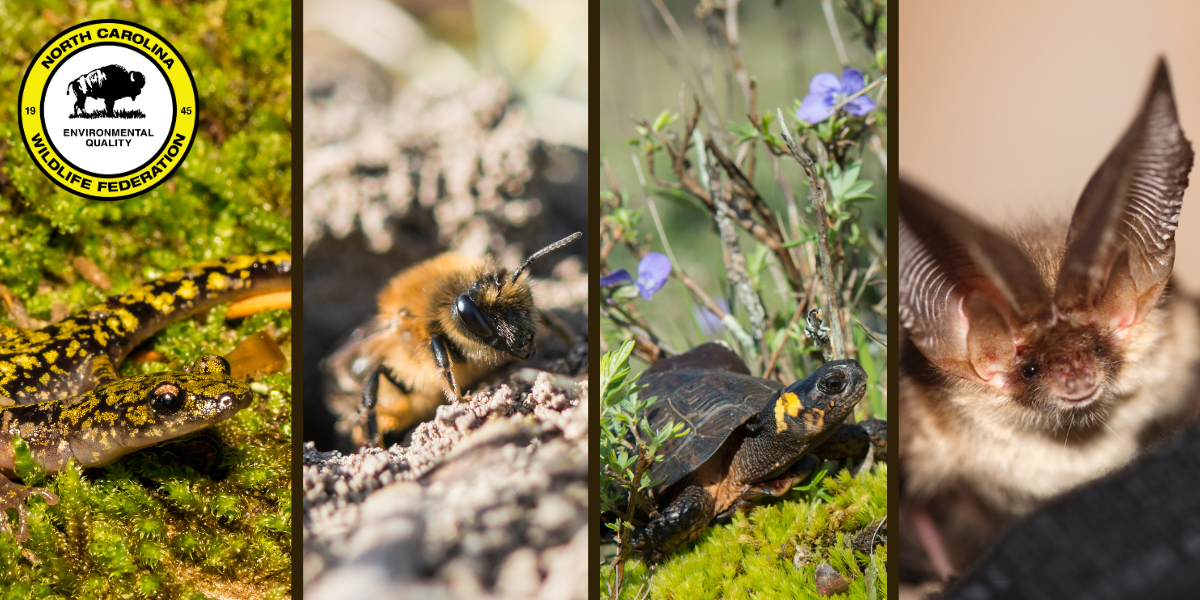
You might be familiar with the term “charismatic megafauna”, denoting species of large animals that attract popular attention. It probably will not come as a surprise that neither the northern long-eared bat, the tiny mason bee, nor the 18-inch-long eastern hellbender fall into this charismatic megafauna category.
But these species – though perhaps smaller than others – are no less important than their “mega” counterparts. Ecosystems depend on all native species to maintain balance, and that includes species that often go unnoticed by us – or even those that intentionally hide from human observation.
In June, 2023, we celebrated Hidden Wildlife species. We highlight a few of these species that are vitally important to our NC ecosystems… some of which are facing population declines.
The popular saying holds true: “You never know what you’ve got until it’s gone”. But how can you keep something from disappearing if you don’t know it’s there in the first place?
Here’s to recognizing a few of these more elusive wildlife species and working hard to make sure they do not disappear forever.
Bats
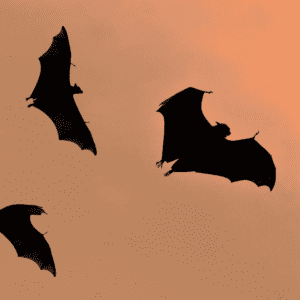 Most people are familiar with bats. They are a common media image (think the iconic superhero, Batman) and are on full display during October around Halloween. However, few people have close encounters with bats – and there are several reasons for that lack of exposure.
Most people are familiar with bats. They are a common media image (think the iconic superhero, Batman) and are on full display during October around Halloween. However, few people have close encounters with bats – and there are several reasons for that lack of exposure.
First off, bats are nocturnal, meaning they only come out of their homes at night. This is to the bat’s advantage, as coming out at night allows them to avoid competition with other insect-eating carnivores, avoid daytime predators, and maintain body temperature and moisture.
During the daytime, bats remain in places like tree cavities, rock crevices, and in quiet areas within buildings – including houses and barns. To avoid harm to bats and to reduce the chance of accidental bat/human interactions, it is best to regularly check your attics and crawl spaces for bats and provide alternative and ideal living spaces for them – such as bat boxes.
Bats live on a diet of insects, which they hunt at night using echolocation. Bats emit high-frequency sounds that bounce off of objects and return to the bat’s ears to inform them of the object’s size, movement, and texture. This also prevents bats from running into objects while in flight. When in need of water, bats will drop their bottom jaw and swoop down to a water source, taking in gulps of water while in mid-flight.
Bats are incredibly important to our ecosystem, as they keep insect populations under control – including rampant mosquito populations. According to the North Carolina Wildlife Resources Commission (NCWRC), it is possible for a nursing female bat to consume nearly her entire body weight in insects in one night alone.
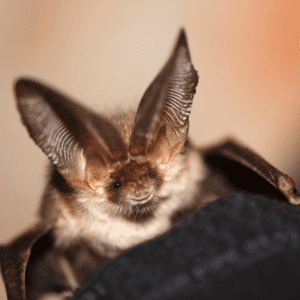
Northern long eared bat
Some bats – such as the northern long-eared bat – are in decline due to habitat loss and white-nose syndrome, a deadly fungal disease. Habitat loss remains a crucial threat to the northern long-eared bat and all bat species that use trees for roosting.
Unfortunately, bats often get a bad rap. This is largely due to their use in popular horror and fantasy stories that exaggerate the danger bats pose to humans. While much of this exaggerated fear comes from their nocturnal behavior, fangs, and association with vampires, bats are capable of transmitting the rabies virus. However, less than 1 out of every 200 randomly sampled bats are infected with rabies. As such, bats are not very dangerous to humans – particularly since they avoid contact with humans and most interactions are accidental. That being said, if you come in contact with a bat of any kind, it is always best to reach out to your doctor to assess the risk associated with the interaction to see if further medical intervention is needed.
Salamanders
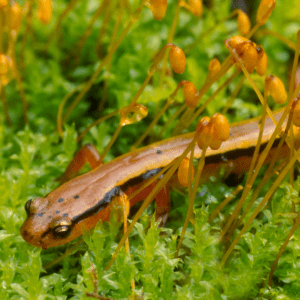
Blue ridge two lined salamander
North Carolina is home to approximately 56 species of salamander – including the blue ridge two-lined salamander, spotted salamander, mole salamander, and mudpuppy salamander (not to be confused with the hellbender salamander, mentioned later in this blog).
Salamanders are amphibians that live in and around bodies of water, or in moist soil habitats. They prefer the cover of darkness and often live under rocks, vegetation, or underwater.
Their diet is composed of insects, spiders, worms, and larvae – including mosquito larvae.
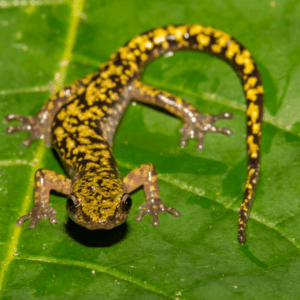
Green salamander
Salamanders are covered in a slimy mucus that protects their permeable skin, enables systemic function and – in some cases – provides defense against predators. As animals with permeable skin, salamanders are sensitive to toxins and pollution and are often great indicators of ecosystem health.
Some salamander species – such as the NC native green salamander – are incredibly difficult to find, as they live in inaccessible rock crevices and only emerge at night. As a result of their hidden existence, and due to a decline in sightings over the past few years, the green salamander is listed as threatened. The NCWRC is continuing research on this species to determine its population size and range.
Southern Bog Turtle
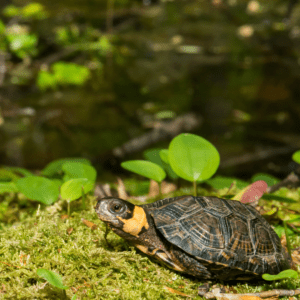
Bog turtle
Some hidden species are hard to spot due to their declining populations… and because they are just so very small.
The southern bog turtle (Glyptemys muhlenbergii) is the smallest turtle in North America, and only grows to less than five inches in length, roughly the width of the human palm. This species has unique coloration, nearly all dark save for a yellow, splotchy band around its neck.
They have an omnivorous diet, eating plants, worms, insects, and snails.
Bog turtles normally live to be 10 years old in the wild, but are capable of living to 60 years old in protected habitats.
The species is listed as threatened, with only 100 populations found within 24 counties in western North Carolina. Their decline is attributed almost entirely to the loss of bog habitat which the turtle depends upon.
If you come across a bog turtle, you can report the sighting to NCWRC.
Hellbender
Allegheny alligator, devil dog, snot otter. These are just a few nicknames given to one of the most iconic North Carolina species…. the eastern hellbender (Cryptobranchus a. alleganiensis).

Eastern hellbender
The hellbender stands out as the largest salamander in the state and one of only three giant salamanders found in the world. Despite their size (averaging 16-17 inches in length and sometimes weighing more than three pounds), seeing one is no easy task. They are masters of disguise. As many of their nicknames imply, the skin on the eastern hellbender is dark and mud like, camouflaging them from predators and unsuspecting prey.
Like many species of salamander, hellbenders live long lives as compared to other wildlife. It is not uncommon for an eastern hellbender to live for at least 30 years.
Hellbenders reside in rivers and large streams with clean, clear, and fast-moving water containing high oxygen levels. They need large, flat rocks and submerged trees both to make nest sites and protect themselves from predators. If the preferred flat rocks are not available, hellbenders will also utilize holes in streambanks.
Though they mostly eat crayfish, hellbenders may eat the occasional fish. However, contrary to popular belief, hellbenders have little impact on fish populations and are not a danger to the quality of trout fisheries.
Native Bees
Some of the most carefully hidden species in NC are some of our most important species. This is certainly true of native bees, of which there are more than 500 species in the state.
According to the US Department of Agriculture, native bees – including mason bees, leafcutter bees, mining bees and bumble bees – account for the pollination of approximately 75 percent of all vegetables, fruits and nuts in the United States.
Different types of native bees have very different ways of living, hiding and moving through the world. Let’s take a look at a few here.
Mason and Leafcutter Bees
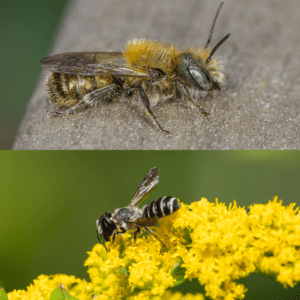
Mason bee (top) and leafcutter bee (bottom)
Mason and leafcutter bees live in the hollow stems of decaying grasses and plant stalks. Within the stalk of a plant, leafcutter bees will line and segment their nests with pieces of leaves that they sever with their strong mandibles. Mason bees nest in a similar manner but use mud and sand to segment their nests into chambers for egg-laying.
Due to their nesting in matured plants and grasses, there is increasing attention around delaying the cutting of lawns and “leaving the leaves”, allowing plants and decaying yard debris to become nesting sites for native mason and leafcutter bees, as well as other species like mining bees.
Mining Bees
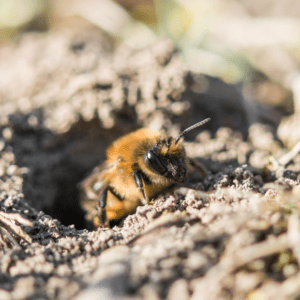
Mining bee
Mining bees are unique among native bees, as they nest underground. While many mason bees only nest an inch below the surface, some dig down an entire foot.
Similar to many bee species, the females are the powerhouses of the colony. All mining bee females secrete a waterproof substance that protects developing larvae from moisture and keeps bacteria from getting into the hive.
Bumble Bees
Bumble bees form small colonies with 50 to several hundred bees. Similar to domesticated honeybees, species reproduction occurs through a new queen being produced by the hive, who leaves and essentially creates her own hive. Unlike honeybees, however, bumble bee colonies die out at the end of each summer, leaving the queen to live through the winter and form a new colony come spring.
Keep Them Hidden, Keep Them Safe
In this blog, we have barely scratched the surface of all of the hidden wildlife species that our North Carolina ecosystems rely on. The unfortunate reality is that all of the above species are facing threats: bats from diseases and habitat loss, salamanders from pollution and streamside erosion, bog turtles from the loss of their specialized bog habitat, and native bees from pesticides, invasive plant species, habitat loss, and competition from domesticated bee species.
However, there is still hope for these species, if we are willing to work for their safety and conservation. NCWF is confronting all of these issues head on, through encouraging and facilitating research in wildlife disease mitigation, organizing habitat restoration projects and trash cleanups, removing invasive plants, and working toward critical wildlife legislation such as Recovering America’s Wildlife Act. If Recovering America’s Wildlife Act is passed into law, protections and resources will be allocated to the conservation of species in need.
You can help make a tangible impact for hidden wildlife species – and all NC wildlife species – by:
- Gardening for Wildlife and registering your yard as a pollinator Pitstop along the Butterfly Highway.
- Volunteering to restore habitat in your community with your local NCWF Wildlife Chapter.
- Participating in a NCWF Wildlife Webinar to learn more about wildlife in NC and the habitat they need to survive and thrive.
- Investing in wildlife and habitat conservation by making a donation to NCWF online or through your donor advised fund, IRA, or stock.
- Contacting your elected officials and those responsible for ensuring wildlife and their habitat are here for future generations to enjoy as well.

– Written by Bates Whitaker, NCWF Communications & Marketing Manager

